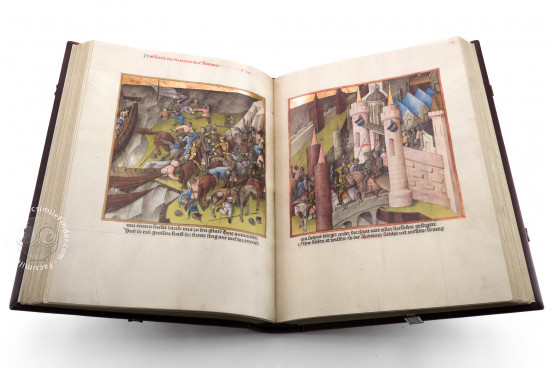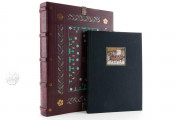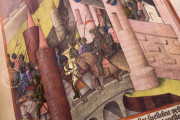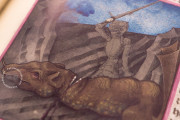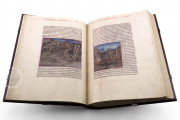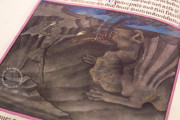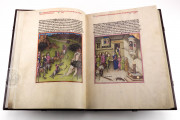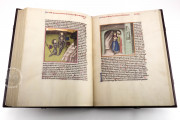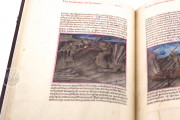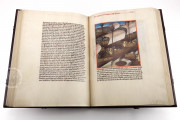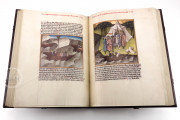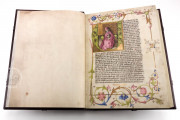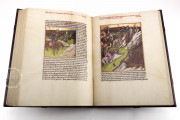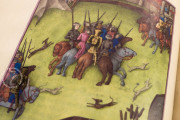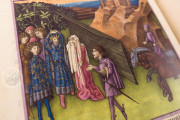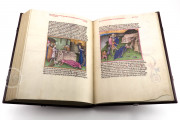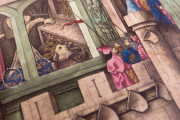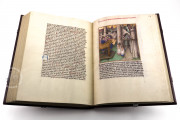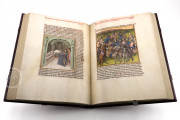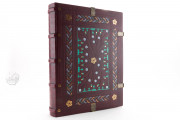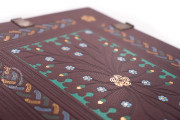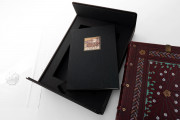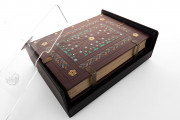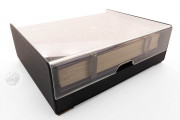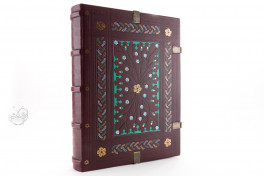Guido de Columnis wrote his version of the Trojan story as early as the thirteenth century, and the popularity of the codex is attested to by the high number of existing translations. This manuscript, with its outstanding miniatures, was made in Regensburg in the fifteenth century and can be regarded as a handbook of court life in the Middle Ages.
The Fascination of Troy
Hardly any other ancient legend exudes, even today, the same fascination as the story of the downfall of Troy. The episodes of the abduction of Helen, wife of the King of Greece, by her lover Paris, the dramatic battles between the heroes Hector and Achilles, and not least the outwitting of the inhabitants of Troy by using the Trojan Horse, are all part of our cultural heritage and identity.
The legend of Troy, however, was particularly dear to the aristocratic world of the Middle Ages, when countless noble families invented Trojan ancestors, ascribing their own genealogy to different heroes of Troy.
Guido's Translation of the Roman de Troie: Extremely Popular throughout Europe
The popularity of the legend in the Middle Ages was thus less based on Homer's or Virgil's epics anchored in the world of pagan deities than on alleged eye-witness reports that pretended to reproduce the events on the battle-fields in all detail.
This was also the source for the Sicilian Guido de Columnis, whose Historia destructionis Troiae achieved incredible fame in the thirteenth century and was translated into numerous languages.
The Longest Cycle on Troy in the German-speaking World
Vol. 2773 in the Austrian National Library presents one of the most unusual Troy manuscripts dating from the late Middle Ages: although a word-for-word translation of Guido's Romance of Troy, the volume is mostly intended as a picture book.
Its 334 miniatures on 478 pages, in the format 27.5 x 37 cm, comprise the most extensive Troy Cycle in the German-speaking world, enabling the reader to experience the entire heroic tale, from the Legend of the Argonauts to the tragic death of Ulysses.
The initial makers spared no expense in producing the manuscript. The translation was done especially for this purpose, the text written down in textura, a highly representative book hand. The special charm of this manuscript lies in its enchanting miniatures.
Handbook of the Courtly World
The Romance of Troy may be considered as a handbook for the courtly world of the Middle Ages.
In addition to the battle scenes which, in spite of their drastic bluntness, rather convey a romantically transfigured image of medieval fighting, the manuscript is above all intended as the presentation of the courtly society, its universe, customs, and rituals, thus making the book an outstanding source of information about medieval court ceremonials.
A Shelf-mark in Golden Letters
Written in golden letters, the words Martinus Opifex (Martin, creator of this work) appear on the first page of the volume, bearing testimony to the proud illuminator. Lucky circumstances allow us to identify him as the illuminator Martin active in Regensburg from 1432 to 1456.
It is certainly no coincidence that this gifted artist was active there, since the old Royal Palace of Regensburg was among the most prominent centers of medieval illumination. Its workshops produced true masterpieces, such as the monumental Ottheinrich Bible.
Master Martinus Opifex from Regensburg
Martin’s individual and highly distinctive style allows us to attribute other manuscripts to his hand. The artist was highly respected by his contemporaries, and he also played a leading role at the Court of Vienna in the 1440s, taking part in the illumination of two volumes for the king of Germany and later Emperor Frederick III.
A Painted Manuscript in Return for Thirty Pounds of Silver
Despite its outstanding decoration and prestigious character, the manuscript contains no indication of its initial destination. The book stayed with the artist himself until his widow sold it in 1456 to the Council of Regensburg City, for the handsome amount of approx. thirty pounds of silver, converted to our standards.
The volume then traveled to Vienna as a gift to the Imperial Chancellor, and later entered the possessions of the Habsburg dynasty: Emperor Maximilian I was one of its owners.
From ca. 1574 onwards, the Viennese Romance of Troy was kept at the Ambras Castle in Tyrol, as part of the library of Ferdinand II, from where it was later transferred back to Vienna, together with most of the Ambras collection.
Apart from the binding, restored in 1951, the entire volume has survived to the present day and is in excellent conditions.
We have 2 facsimiles of the manuscript "Guido de Columnis - The Trojan War":
- Guido de Columnis: Der Trojanische Krieg facsimile edition published by Faksimile Verlag, 2007
- Guido de Columnis: Der Trojanische Krieg facsimile edition published by Wissen Media Verlag GmbH, 2007


